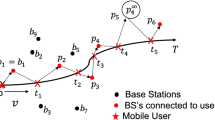Abstract
We address in this paper the autonomous derivation of re-use criteria, needed for channel assignment in channelized wireless voice and data communications systems, and of neighbor lists, needed for call-processing functions. We present an approach that relies on signal strength measurements collected by the system itself, during operation. This approach can be implemented with conventional equipment and functionality provided by the current air interface standards for circuit-based and packet-based access, employing either centralized or distributed control. No regularity requirements are imposed on the grid of cells or on the RF re-use pattern, and no knowledge is assumed of the base station locations. We describe the data collection mechanism and design the associated statistical hypothesis tests.
Similar content being viewed by others
References
N. Bambos, S. Chen and G. Pottie, Radio link admission algorithms for wireless networks with power control and active link quality protection, in: Proc. INFOCOM 95, Boston, MA, 1995.
M. Benveniste, Apparatus and method for nonregular channel assignment in wireless communication networks, U.S. Patent #5,404,574 (May 1992).
M. Benveniste, An optimization model for nonregular channel assignment in wireless communications networks, in: Proc. of AT&T Networks and Systems Performance Symposium,Holmdel,NJ, 28–29 September 1993.
M. Benveniste, Adaptive-dynamic channel assignment organization system and method, U.S. Patent #5,809,423 (March 1995).
M. Benveniste, Solution of the nonregular channel assignment problem in wireless communications systems through generalized linear programming, in: EURO INFORMS XXXIV Joint Internat. Conf., Barcelona, Spain, July 1997.
M. Benveniste, Self-configurable wireless systems: Spectrum monitoring in a layered configuration, in: Proc. GLOBECOM 2000, Rio de Janeiro, Brazil, December 1999.
M. Benveniste, System and method for managing neighbor-channel interference in channelized cellular systems, U.S. Patent #5,740,536.
M. Benveniste, Mixed power control with directed assignment (MPCDA), a method for interference reduction in channelized wireless systems, Telecommunications Systems (in press); U.S. Patent #5,787,352.
M. Benveniste, System and method for managing neighbor-channel interference with power control and directed channel assignment, U.S. Patent #5,787,352.
J. Chuang, Autonomous adaptive frequency assignment for TDMA portable radios systems, IEEE Transactions on Vehicular Technology 40 (1991) 627–635.
L.J. Cimini, Jr., G.J. Foschini and C.-L. I, Call blocking performance of distributed algorithms for dynamic channel allocation in microcells, IEEE Transactions on Communications (August 1994) 2600.
D.C. Cox and D.O. Reudink, The behavior of dynamic channel assignment mobile communications systems as a function of number of radio channels, IEEE Transactions on Communications 20 (November 1972) 471–479.
G.J. Foschini and Z. Miljanic, A simple distributed autonomous power control algorithm and its convergence, IEEE Transactions on Vehicular Technology 42 (1993).
S. Grandhi et al., Centralized power control in cellular radio systems, IEEE Transactions on Vehicular Technology 42 (1993).
Z.J. Haas, J.H. Winters and D.S. Johnson, Simulation results of the capacity of cellular systems, IEEE Transactions on Vehicular Technology 46 (1997) 805–817.
S.W. Halpern, Re-use partitioning in cellular systems, in: Proc. of the 33rd Vehicular Technology Conf., 1983, pp. 322–327.
I. Katzela and M. Naghshineh, Channel assignment schemes for cellular mobile telecommunication systems: A comprehensive survey, IEEE Personal Communications Magazine (1996).
V.H. MacDonald, Advanced mobile phone service: the cellular concept, Bell System Technical Journal 58 (1979) 15-41.
R. Nettleton and G.R. Schloemer, A high capacity assignment method for cellular mobile systems, in: Proc. of Vehicular Technology Conference 89, May 1989, pp. 359–367.
R.J. Pennotti, Channel assignment in cellular mobile telecommunication systems, Ph.D. dissertation, Polytechnic Institute of New York (June 1976).
J.F. Whitehead, Performance and capacity of distributed dynamic channel assignment and power control in shadow fading, in: Vehicular Technology Conf., 1993.
J. Zander, Performance of optimum transmitter power control in cellular radio systems, IEEE Transactions on Vehicular Technology 41 (1992).
Author information
Authors and Affiliations
Rights and permissions
About this article
Cite this article
Benveniste, M. Self-Configuring Wireless Systems: Derivation of Re-Use Criteria and Neighbor-Lists. Telecommunication Systems 21, 231–248 (2002). https://doi.org/10.1023/A:1020946531334
Issue Date:
DOI: https://doi.org/10.1023/A:1020946531334




